Network Data Leakage: Analysis of Threats and Prevention Strategies
VerifiedAdded on 2023/03/20
|5
|1091
|70
Report
AI Summary
This report examines the critical issue of network data leakage, detailing its various causes and offering practical countermeasures. The report identifies unauthorized application use, misuse of corporate computers, and poor password practices as primary contributors to data breaches. It highlights the risks associated with these vulnerabilities, including the potential loss of sensitive corporate and personal data. To mitigate these risks, the report proposes several countermeasures, including the monitoring of network activity and access, the implementation of encryption protocols, and the identification of critical data that requires the highest level of protection. The report emphasizes the importance of a layered defense system, combining proactive monitoring with effective network management to prevent data leakage and protect valuable information assets. The report also includes a comprehensive list of references to support the findings and recommendations.
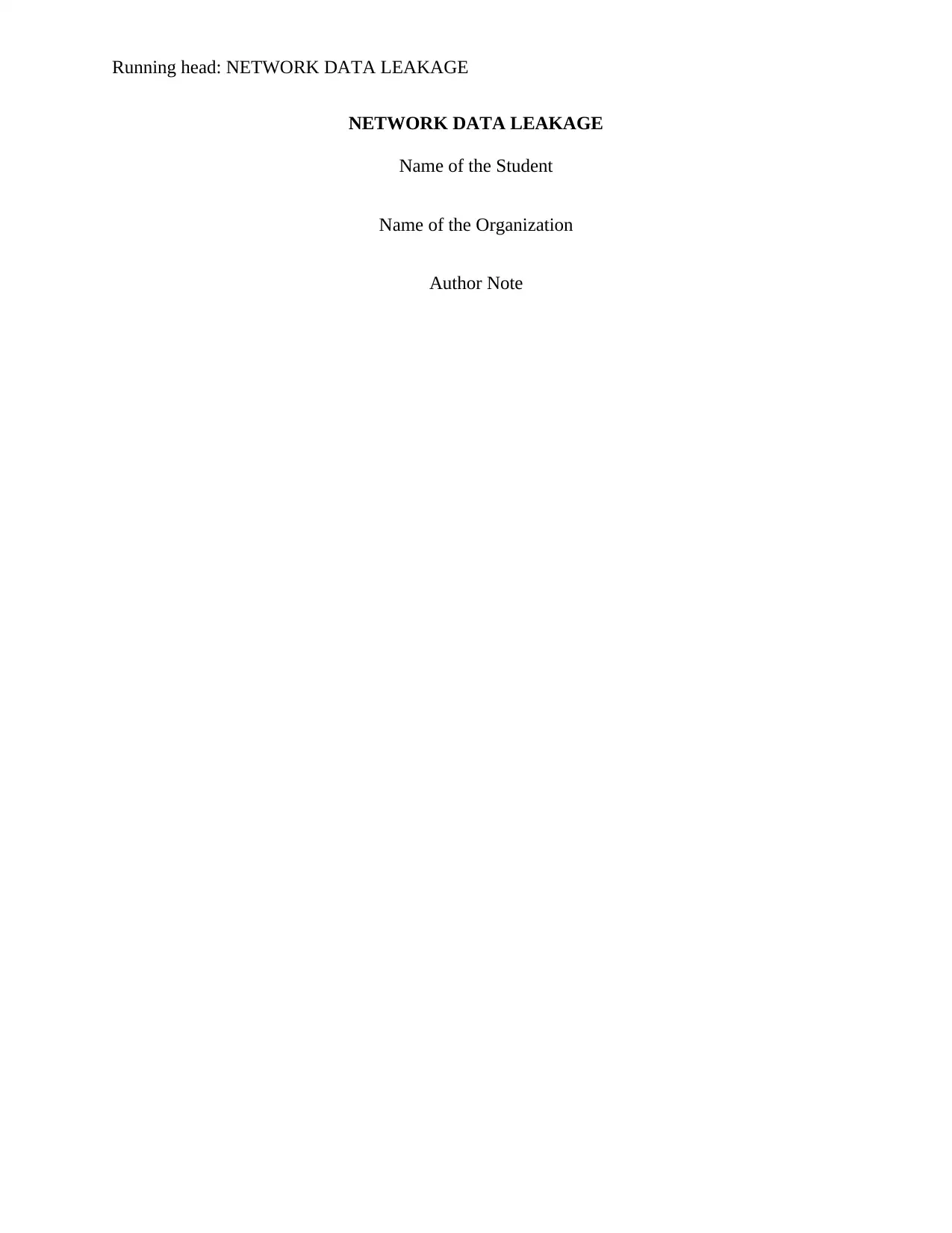
Running head: NETWORK DATA LEAKAGE
NETWORK DATA LEAKAGE
Name of the Student
Name of the Organization
Author Note
NETWORK DATA LEAKAGE
Name of the Student
Name of the Organization
Author Note
Paraphrase This Document
Need a fresh take? Get an instant paraphrase of this document with our AI Paraphraser
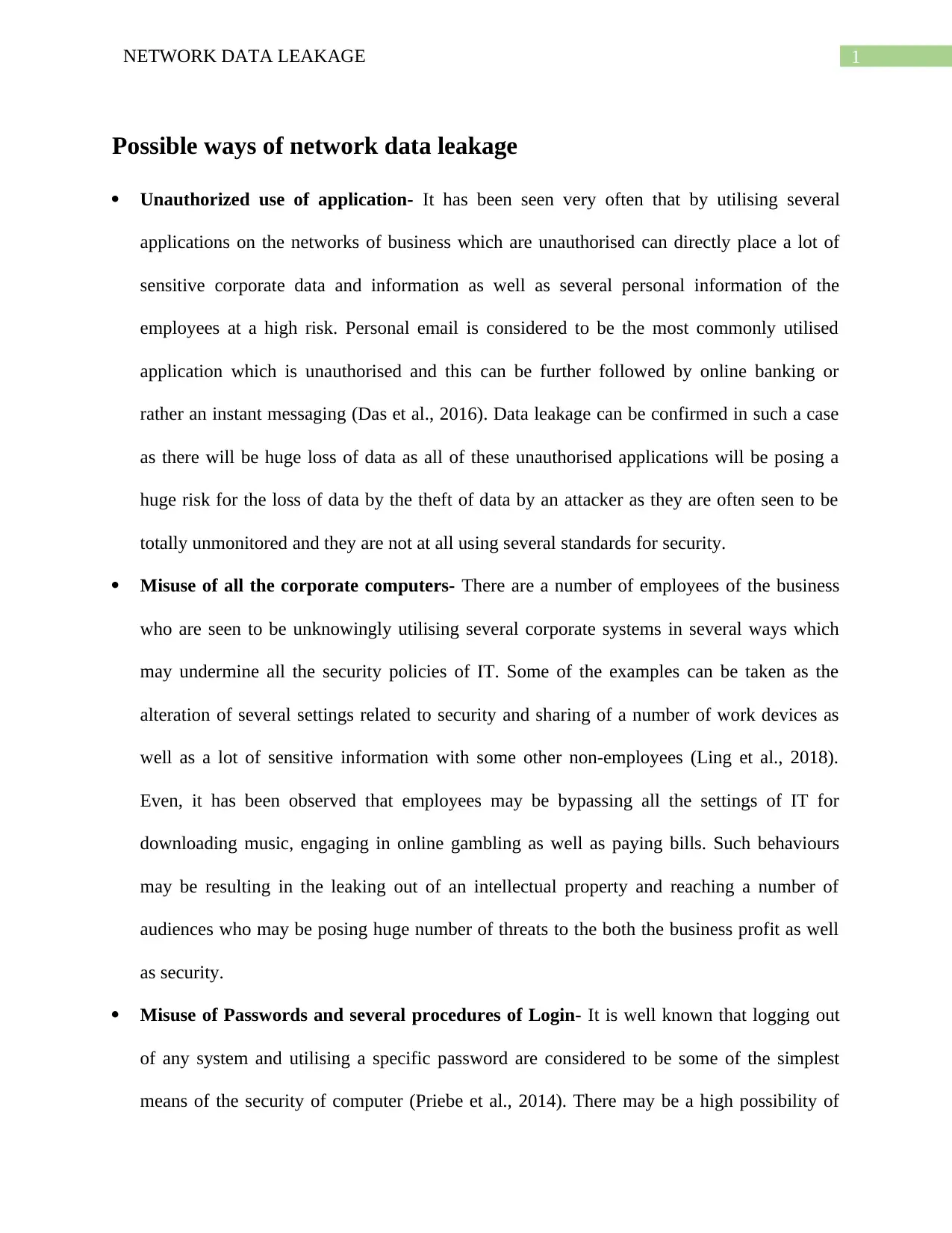
1NETWORK DATA LEAKAGE
Possible ways of network data leakage
Unauthorized use of application- It has been seen very often that by utilising several
applications on the networks of business which are unauthorised can directly place a lot of
sensitive corporate data and information as well as several personal information of the
employees at a high risk. Personal email is considered to be the most commonly utilised
application which is unauthorised and this can be further followed by online banking or
rather an instant messaging (Das et al., 2016). Data leakage can be confirmed in such a case
as there will be huge loss of data as all of these unauthorised applications will be posing a
huge risk for the loss of data by the theft of data by an attacker as they are often seen to be
totally unmonitored and they are not at all using several standards for security.
Misuse of all the corporate computers- There are a number of employees of the business
who are seen to be unknowingly utilising several corporate systems in several ways which
may undermine all the security policies of IT. Some of the examples can be taken as the
alteration of several settings related to security and sharing of a number of work devices as
well as a lot of sensitive information with some other non-employees (Ling et al., 2018).
Even, it has been observed that employees may be bypassing all the settings of IT for
downloading music, engaging in online gambling as well as paying bills. Such behaviours
may be resulting in the leaking out of an intellectual property and reaching a number of
audiences who may be posing huge number of threats to the both the business profit as well
as security.
Misuse of Passwords and several procedures of Login- It is well known that logging out
of any system and utilising a specific password are considered to be some of the simplest
means of the security of computer (Priebe et al., 2014). There may be a high possibility of
Possible ways of network data leakage
Unauthorized use of application- It has been seen very often that by utilising several
applications on the networks of business which are unauthorised can directly place a lot of
sensitive corporate data and information as well as several personal information of the
employees at a high risk. Personal email is considered to be the most commonly utilised
application which is unauthorised and this can be further followed by online banking or
rather an instant messaging (Das et al., 2016). Data leakage can be confirmed in such a case
as there will be huge loss of data as all of these unauthorised applications will be posing a
huge risk for the loss of data by the theft of data by an attacker as they are often seen to be
totally unmonitored and they are not at all using several standards for security.
Misuse of all the corporate computers- There are a number of employees of the business
who are seen to be unknowingly utilising several corporate systems in several ways which
may undermine all the security policies of IT. Some of the examples can be taken as the
alteration of several settings related to security and sharing of a number of work devices as
well as a lot of sensitive information with some other non-employees (Ling et al., 2018).
Even, it has been observed that employees may be bypassing all the settings of IT for
downloading music, engaging in online gambling as well as paying bills. Such behaviours
may be resulting in the leaking out of an intellectual property and reaching a number of
audiences who may be posing huge number of threats to the both the business profit as well
as security.
Misuse of Passwords and several procedures of Login- It is well known that logging out
of any system and utilising a specific password are considered to be some of the simplest
means of the security of computer (Priebe et al., 2014). There may be a high possibility of
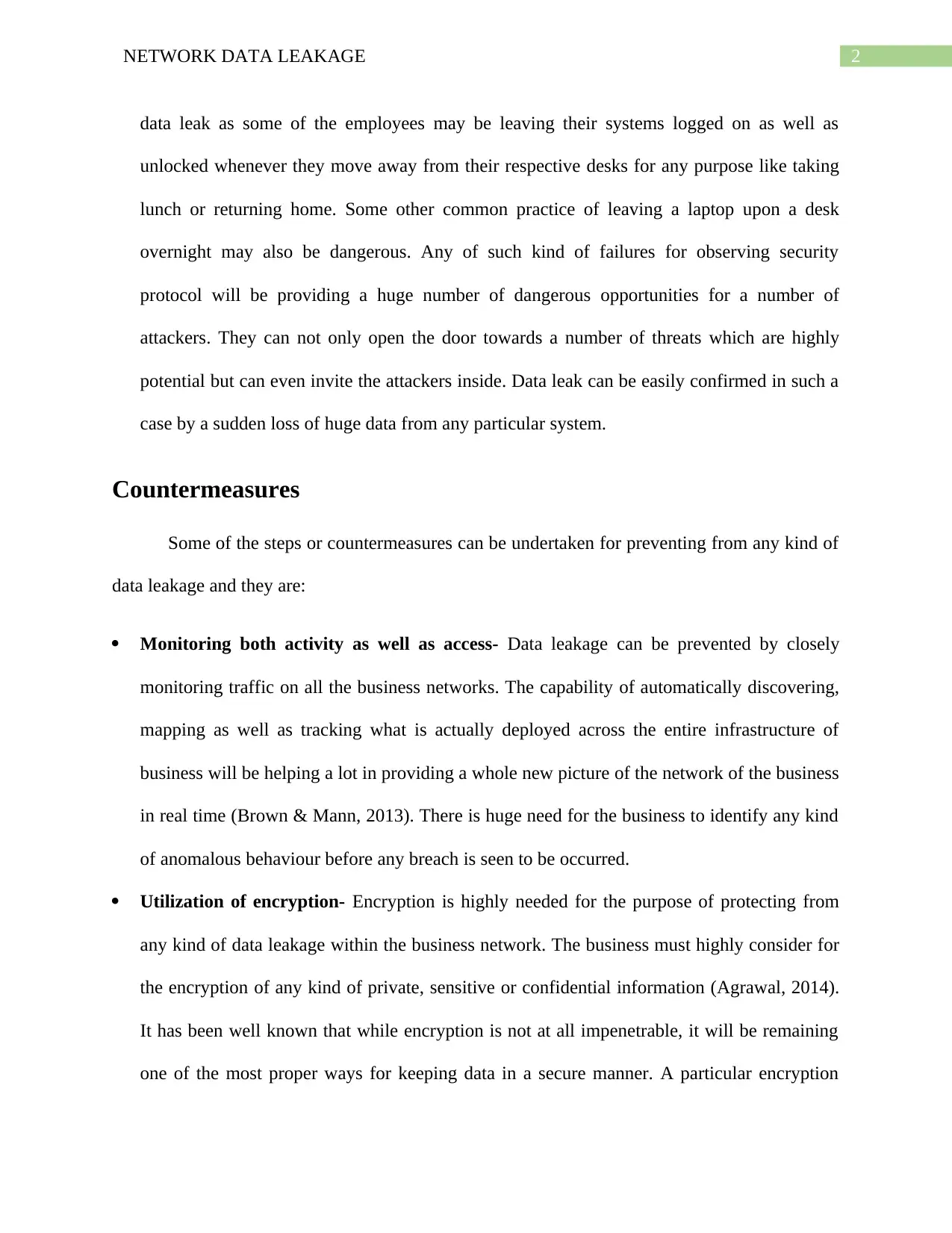
2NETWORK DATA LEAKAGE
data leak as some of the employees may be leaving their systems logged on as well as
unlocked whenever they move away from their respective desks for any purpose like taking
lunch or returning home. Some other common practice of leaving a laptop upon a desk
overnight may also be dangerous. Any of such kind of failures for observing security
protocol will be providing a huge number of dangerous opportunities for a number of
attackers. They can not only open the door towards a number of threats which are highly
potential but can even invite the attackers inside. Data leak can be easily confirmed in such a
case by a sudden loss of huge data from any particular system.
Countermeasures
Some of the steps or countermeasures can be undertaken for preventing from any kind of
data leakage and they are:
Monitoring both activity as well as access- Data leakage can be prevented by closely
monitoring traffic on all the business networks. The capability of automatically discovering,
mapping as well as tracking what is actually deployed across the entire infrastructure of
business will be helping a lot in providing a whole new picture of the network of the business
in real time (Brown & Mann, 2013). There is huge need for the business to identify any kind
of anomalous behaviour before any breach is seen to be occurred.
Utilization of encryption- Encryption is highly needed for the purpose of protecting from
any kind of data leakage within the business network. The business must highly consider for
the encryption of any kind of private, sensitive or confidential information (Agrawal, 2014).
It has been well known that while encryption is not at all impenetrable, it will be remaining
one of the most proper ways for keeping data in a secure manner. A particular encryption
data leak as some of the employees may be leaving their systems logged on as well as
unlocked whenever they move away from their respective desks for any purpose like taking
lunch or returning home. Some other common practice of leaving a laptop upon a desk
overnight may also be dangerous. Any of such kind of failures for observing security
protocol will be providing a huge number of dangerous opportunities for a number of
attackers. They can not only open the door towards a number of threats which are highly
potential but can even invite the attackers inside. Data leak can be easily confirmed in such a
case by a sudden loss of huge data from any particular system.
Countermeasures
Some of the steps or countermeasures can be undertaken for preventing from any kind of
data leakage and they are:
Monitoring both activity as well as access- Data leakage can be prevented by closely
monitoring traffic on all the business networks. The capability of automatically discovering,
mapping as well as tracking what is actually deployed across the entire infrastructure of
business will be helping a lot in providing a whole new picture of the network of the business
in real time (Brown & Mann, 2013). There is huge need for the business to identify any kind
of anomalous behaviour before any breach is seen to be occurred.
Utilization of encryption- Encryption is highly needed for the purpose of protecting from
any kind of data leakage within the business network. The business must highly consider for
the encryption of any kind of private, sensitive or confidential information (Agrawal, 2014).
It has been well known that while encryption is not at all impenetrable, it will be remaining
one of the most proper ways for keeping data in a secure manner. A particular encryption
⊘ This is a preview!⊘
Do you want full access?
Subscribe today to unlock all pages.

Trusted by 1+ million students worldwide
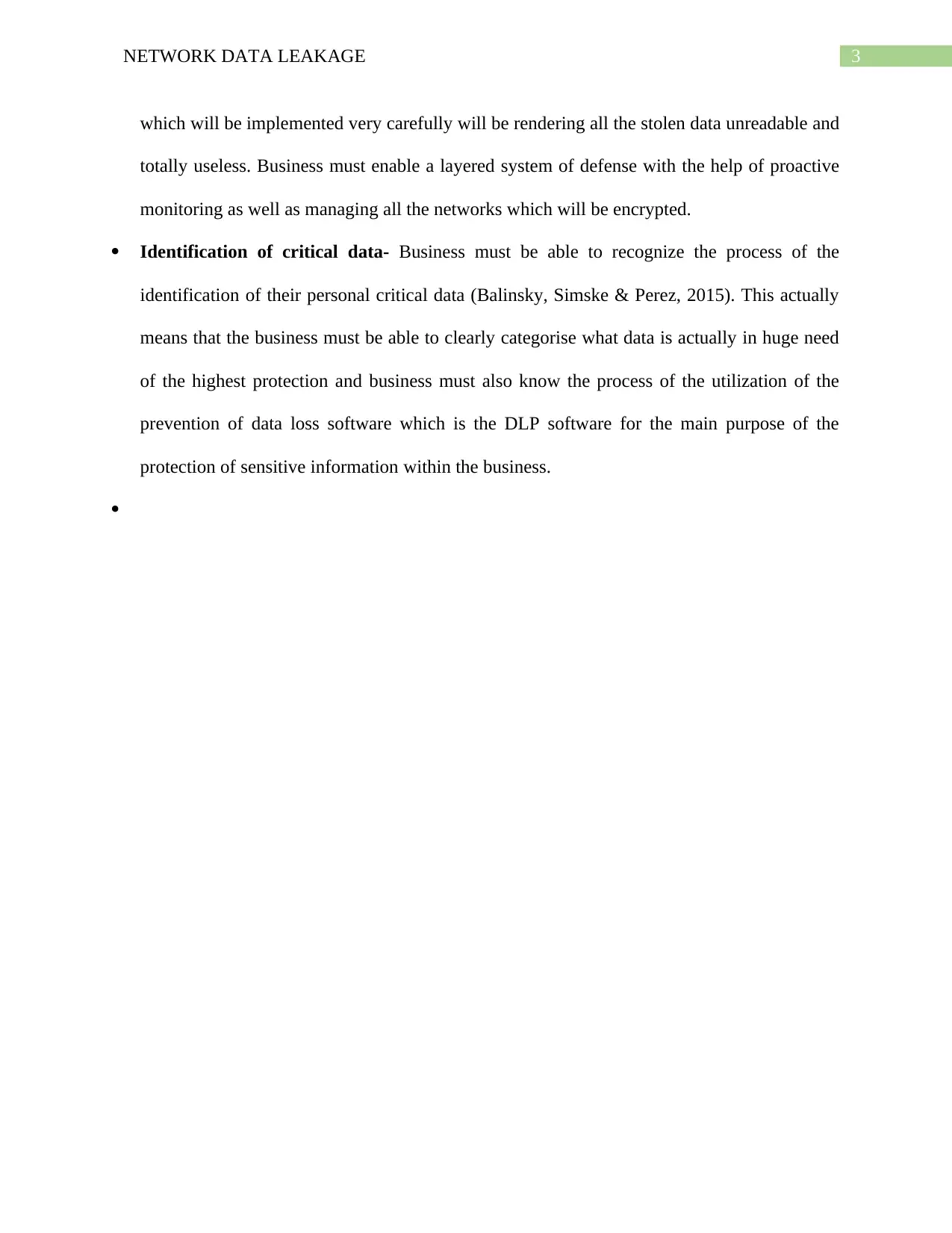
3NETWORK DATA LEAKAGE
which will be implemented very carefully will be rendering all the stolen data unreadable and
totally useless. Business must enable a layered system of defense with the help of proactive
monitoring as well as managing all the networks which will be encrypted.
Identification of critical data- Business must be able to recognize the process of the
identification of their personal critical data (Balinsky, Simske & Perez, 2015). This actually
means that the business must be able to clearly categorise what data is actually in huge need
of the highest protection and business must also know the process of the utilization of the
prevention of data loss software which is the DLP software for the main purpose of the
protection of sensitive information within the business.
which will be implemented very carefully will be rendering all the stolen data unreadable and
totally useless. Business must enable a layered system of defense with the help of proactive
monitoring as well as managing all the networks which will be encrypted.
Identification of critical data- Business must be able to recognize the process of the
identification of their personal critical data (Balinsky, Simske & Perez, 2015). This actually
means that the business must be able to clearly categorise what data is actually in huge need
of the highest protection and business must also know the process of the utilization of the
prevention of data loss software which is the DLP software for the main purpose of the
protection of sensitive information within the business.
Paraphrase This Document
Need a fresh take? Get an instant paraphrase of this document with our AI Paraphraser
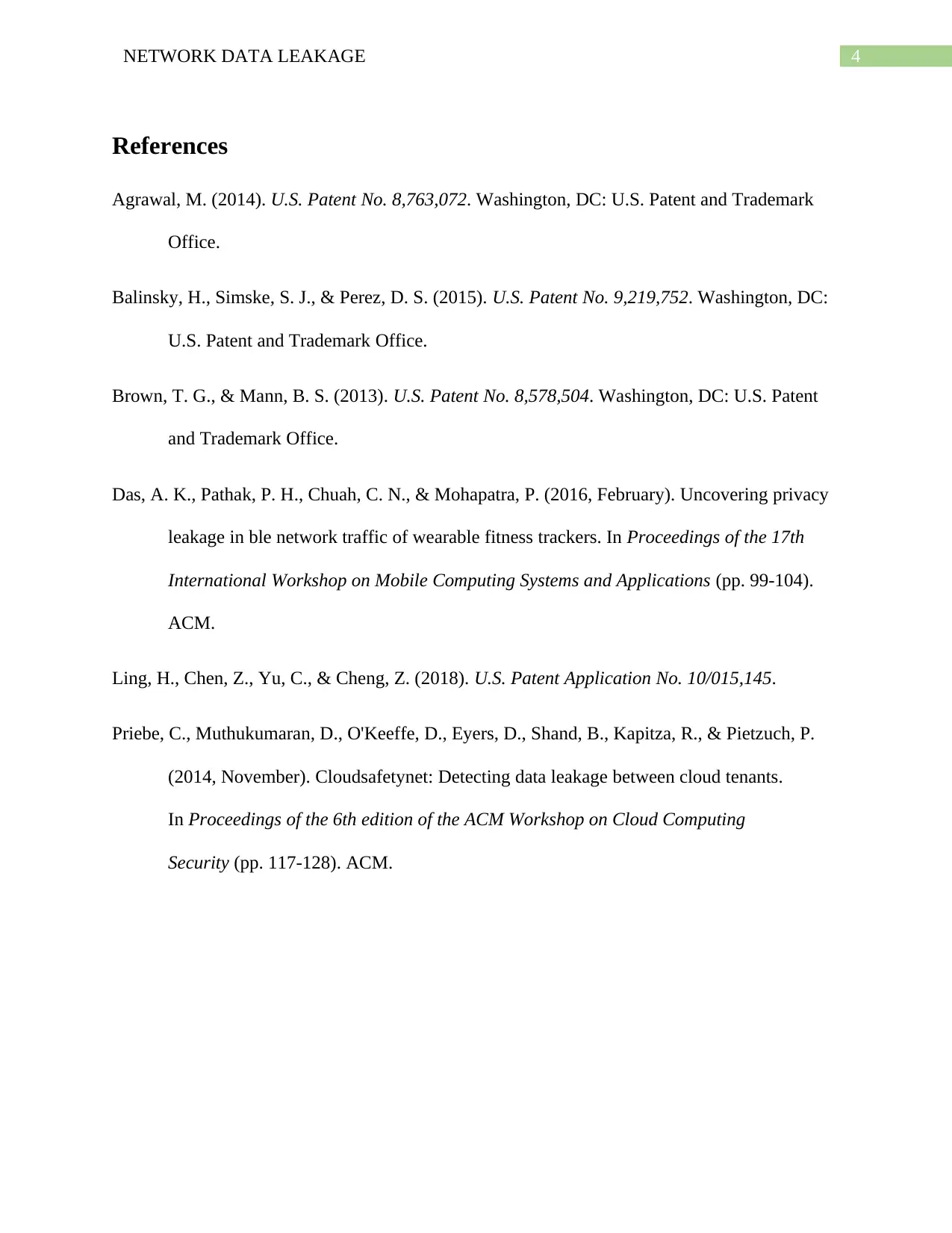
4NETWORK DATA LEAKAGE
References
Agrawal, M. (2014). U.S. Patent No. 8,763,072. Washington, DC: U.S. Patent and Trademark
Office.
Balinsky, H., Simske, S. J., & Perez, D. S. (2015). U.S. Patent No. 9,219,752. Washington, DC:
U.S. Patent and Trademark Office.
Brown, T. G., & Mann, B. S. (2013). U.S. Patent No. 8,578,504. Washington, DC: U.S. Patent
and Trademark Office.
Das, A. K., Pathak, P. H., Chuah, C. N., & Mohapatra, P. (2016, February). Uncovering privacy
leakage in ble network traffic of wearable fitness trackers. In Proceedings of the 17th
International Workshop on Mobile Computing Systems and Applications (pp. 99-104).
ACM.
Ling, H., Chen, Z., Yu, C., & Cheng, Z. (2018). U.S. Patent Application No. 10/015,145.
Priebe, C., Muthukumaran, D., O'Keeffe, D., Eyers, D., Shand, B., Kapitza, R., & Pietzuch, P.
(2014, November). Cloudsafetynet: Detecting data leakage between cloud tenants.
In Proceedings of the 6th edition of the ACM Workshop on Cloud Computing
Security (pp. 117-128). ACM.
References
Agrawal, M. (2014). U.S. Patent No. 8,763,072. Washington, DC: U.S. Patent and Trademark
Office.
Balinsky, H., Simske, S. J., & Perez, D. S. (2015). U.S. Patent No. 9,219,752. Washington, DC:
U.S. Patent and Trademark Office.
Brown, T. G., & Mann, B. S. (2013). U.S. Patent No. 8,578,504. Washington, DC: U.S. Patent
and Trademark Office.
Das, A. K., Pathak, P. H., Chuah, C. N., & Mohapatra, P. (2016, February). Uncovering privacy
leakage in ble network traffic of wearable fitness trackers. In Proceedings of the 17th
International Workshop on Mobile Computing Systems and Applications (pp. 99-104).
ACM.
Ling, H., Chen, Z., Yu, C., & Cheng, Z. (2018). U.S. Patent Application No. 10/015,145.
Priebe, C., Muthukumaran, D., O'Keeffe, D., Eyers, D., Shand, B., Kapitza, R., & Pietzuch, P.
(2014, November). Cloudsafetynet: Detecting data leakage between cloud tenants.
In Proceedings of the 6th edition of the ACM Workshop on Cloud Computing
Security (pp. 117-128). ACM.
1 out of 5
Related Documents
Your All-in-One AI-Powered Toolkit for Academic Success.
+13062052269
info@desklib.com
Available 24*7 on WhatsApp / Email
![[object Object]](/_next/static/media/star-bottom.7253800d.svg)
Unlock your academic potential
Copyright © 2020–2025 A2Z Services. All Rights Reserved. Developed and managed by ZUCOL.





